
"For they [the Ethiopians] state that there are to be seen in their country snakes so great in size that they not only eat both oxen and bulls and other animals of equal bulk, but even join issue in battle with the elephants, and by intertwining their coil about the elephants' legs they prevent the natural movement of them and by rearing their necks above their trunks they put their heads directly opposite the eyes of the elephants, and sending forth, by reason of the fiery nature of their eyes, brilliant flashes like lightning, they first blind their sight and then throw them to the ground and devour of the flesh of their conquered foes."
Diodorus Siculus, Library of History (III.37.9)
Having discussed mankind in his Natural History, Pliny turns to the rest of the animal kingdom, beginning with that creature whose intellect "approaches closest to man in disposition," the elephant (VIII.i.1). Aware of the value of its ivory tusks, it buries them if fallen off and, when surrounded by hunters, put those animals with the smallest tusks in front of the herd so they may not think them with the trouble (VIII.iv.7ff). As to the enmity, says Pliny, the dragon seeks the blood of the elephant, which was purported to be exceptionally cold, to cool itself in the heat of summer. Concealed on a riverbank, it waits for the elephant to drink and then lunges at the extended trunk, biting the animal behind the ear, the only place that the trunk cannot reach. Curiously, the result is the same: such is the size of these dragons that they are able to drain the elephant of all its cooling blood. But then the enervated animal falls to the ground, crushing the bloated snake beneath it (XXIX.xx.67–68).
Pliny later wrote of this natural antipathy, "the serpents also being of so large a size that they easily encircle the elephants in their coils and fetter them with a twisted knot. In this duel both combatants die together, and the vanquished elephant in falling crushes with its weight the snake coiled round it" (VIII.xi.32). Pliny later elaborates on this contest. In attempting to dislodge the entwined serpent, the elephant attempts to do so by rubbing against a tree or rock. Anticipating this, the serpent coils itself around the feet in an attempt to hobble it. And, as the elephant tries to pull it off with its trunk, the snake thrusts its head into the nostrils, in an attempt to suffocate the struggling beast.
Aelian, too, tells of pythons in India enveloping the lower half of their bodies in the branches of trees on which the elephant feeds. The upper part, however, is allowed to hang down like a rope, with which it strangles the elephant as with a noose, first having lunged out to blind it (On the Characteristics of Animals, VI.21).
Solinus, writing in the third century AD, follows Pliny in recounting the story but adds that the serpent, lurking along the path, attacks those elephants trailing the herd, entangling their feet in knotted coils so that they lag behind and cannot be helped. Too, the blood-soaked soil from their fatal combat becomes a pigment called cinnabar (Polyhistor, XXV.11-15; Pliny, XXXIII.xxxviii.116, who adds that, in a painting, cinnabar is the only color that properly represents the color of blood).
Isidore of Seville (d. AD 636) elaborates, adding that elephants have a strong intellect and memory, are afraid of mice, and live 300 years. Mating facing away from one another, the female gives birth only once and then only in the water or on an island for fear of serpents which "are their enemies, and kill them by coiling around them" (The Etymologies, XII.ii.15–16).
Born in the fiery heat of Ethiopia and India, the dragon is "the largest of all the snakes, or all the animals on earth," killing whatever it wraps itself around. Even the elephant, as large as it is, is not safe, "for it lurks around the paths along which the elephants are accustomed to walk, and wraps around their legs in coils and kills them by suffocating them" (XII.iii.4–5). Here, the boa is the enemy of the cow (Latin bos), from which it takes its name from the cows—and kills by attaching itself to those with the fullest udders and sucking them dry (XII.iv28).
An exotic creature, although not so fabulous as the mythical unicorn or phoenix, Elephas the Elephant was one of the most popular animals in the medieval bestiary. It was though to be intelligent and gentle, indeed, "Of all wild animals the most easily tamed and the gentlest" (Aristotle, History of Animals, IX.46). When traveling together, the elephant was careful not to injure its companions with its ivory tusks, tended the wounded and protected them in the middle of the herd, and used its prehensile trunk to gather leaves to feed, hence the name proboscis, "for the bushes."
According with the medieval ideal that sex in marriage be for reproduction only, the elephant symbolized the paradox of chaste marriage and conjugal chastity (as, indeed, did Edward the Confessor). The elephant pair were not concupiscent, just as Adam and Eve originally were in a state of grace before being tempted to disobedience by the fruit of the Garden. So should married couples aspire to that lost innocence and remain chaste, having sexual relations only to bear children. Mating only once, the elephant was a model for human moral behavior. It was supposed that the elephant, being modest, copulated back-to-back (and also to be retromingent, urinating backwards). A faithful spouse, neither quarrelsome or adulterous, the male elephant was a reluctant lover. When the female desired to copulate (which she did only once), she was obliged to take her mate eastward to Paradise, where the mandragora grew. First, she ate of the mandrake root, itself in the shape of a human figure and a reputed aphrodisiac, and then enticed the male to do the same. Seduced, she conceived immediately and gestated for two years before giving birth in the water, while her mate stood guard against dragons.
There is a lesson, too, in the dragon. The Devil was thought to lie in wait, laying the coils of sin in the paths of the righteous, suffocating them by sin and slaying them in its embrace, squeezing out God's breath of life.
Henry III even had one in his menagerie. A gift from Louis IX of France in 1254, it managed to survive for four years in the Tower of London. Drawn from life by Matthew Paris for his Chronica Majora, it was the first elephant to be seen in England since those that accompanied the Roman emperor Claudius more than twelve-hundred years earlier. Yet, even if one could be observed at court (and in spite of classical authority), a naturalistic representation in the bestiary was less important than the symbolism or iconography of the image.
For James, the illustrations seem to be the bestiaries' only attribute. "But for its pictures I do not think that the Book could possibly have gained or kept any sort of popularity." Only its "many beautiful and many curious images" seem to have justified "the spending of some labour on the tracing of its history." In a lecture several years later, James was no less emphatic, declaring that the bestiary has "no scientific or literary merits whatever" and would not even have attracted much attention were it not for the fact that it had been furnished with pictures. And, in fact, it was as a picture book that he examined them, limiting himself only to those English manuscripts in Latin that were illustrated. But James is mistaken, as the editor's introduction to Bodley 764 (below) makes clear. One of the longest chapters in that bestiary is on horses: a trove of information on care, value, breed, color, strength, speed, and suitability that "no social historian of the Middle Ages can neglect."
The elephant sometimes is illustrated twice in the bestiaries, once in the section on animals, carrying armed knights in the tower on its back—and then again with reptiles, where Draco the Dragon is discussed, the tail of which was particularly deadly. The enmity of the dragon and elephant is told separately in the bestiary, where Draco the dragon is discussed, although the dragon often is illustrated without any reference to its traditional adversary. Even though depicted as dragons, in fact, the name applies to a large snake such as the boa or python.

If not carrying men to war, the elephant fought its traditional enemy, the serpent or dragon. Probably written at Lincoln about 1185, the Worksop Bestiary (MS M.81) is the earliest example of the so-called Transitional Family of bestiaries, which adheres to the order of beasts from Physiologus ("The Naturalist," an Alexandrian text written in the second century AD) but which adds material from the Etymologies of Isidore, and presents mammals, birds, fishes, and reptiles in separate groups. It once was owned by William Morris, who purchased it in 1896 for £900, a considerable sum both for the man and his time. Already in ill health, Morris died five months later, almost to the day, the extravagant purchase no doubt gratifying a last indulgent wish. The manuscript now is in the Morgan Library and Museum (New York).

A copy of the Worksop Bestiary (although not direct, as the beaver is illustrated differently in the two manuscripts), Royal 12 C.xix was presented to the British Museum by King George II in 1757. From central or northern England (possibly Durham) and dating to about 1200, it, too, is a Transitional bestiary. A comparison with other bestiaries in the same family reveals that the manuscript is missing several quires, with the resultant loss of a dozen or so beasts (real and imagined), as well as an equal number of birds, and all the fishes.
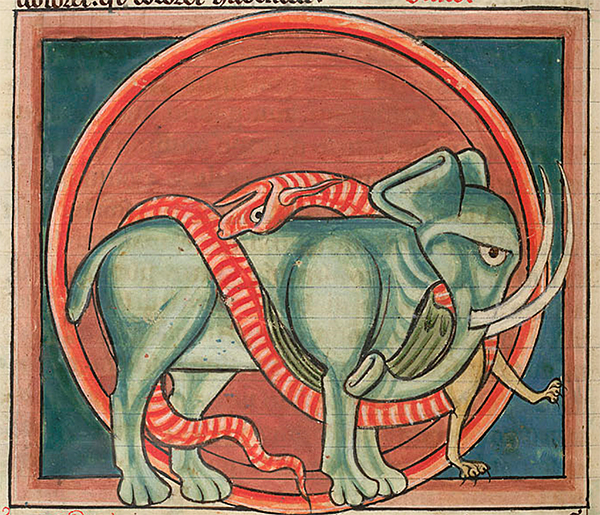
The elephant often is illustrated a second time in the entry for Draco the dragon, , this time placidly entwined in the coils of its adversary. The trunk has begun to change as well (especially noticeable in Royal MS 12 F XIII), looking more open and bell like, perhaps because, as Aristotle contended, "the sound produced is like that of a hoarse trumpet" (IV.9). It was Aristotle, too, that praised the elephant "of all wild animals the most easily tamed and the gentlest"
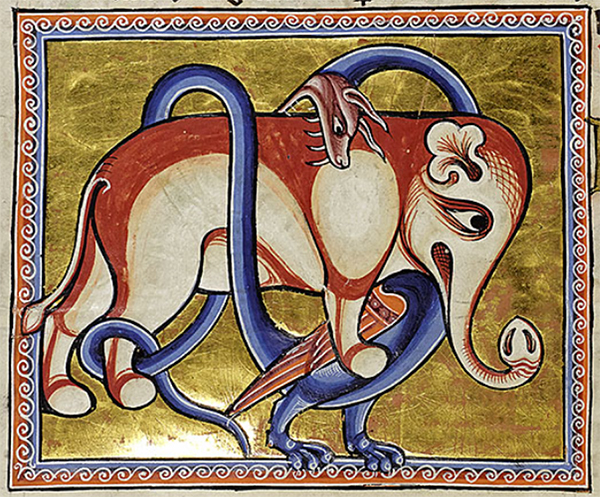
The Aberdeen Bestiary (University of Aberdeen, MS 24), c. 1200–1210 is characterized (like the Ashmole Bestiary) by large illuminations on burnished gold grounds, arbitrary but imaginative coloring, symmetrical patterns, and an emphasis on artistic impression rather than natural observation—the very attributes that make these luxurious bestiaries so engaging. Indeed, for Clarke, the choice and use of color "put the Aberdeen and Ashmole bestiaries among the major colorists of the history of painting."
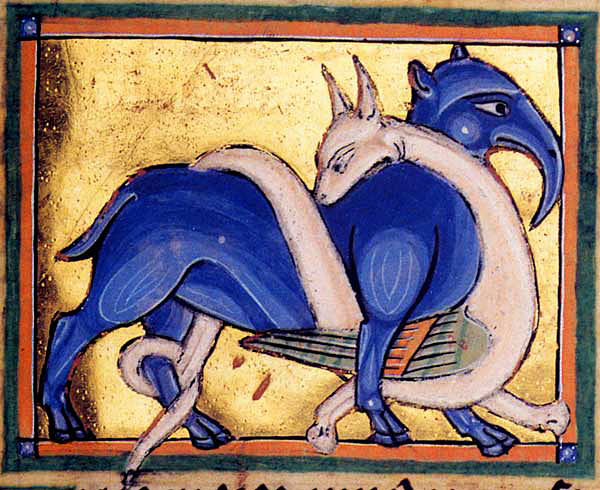
In the Library of St. John's College (Oxford), MS 61 is a Second Family bestiary that dates to about 1220, possibly from York. It has many of the design elements of the Cambridge Bestiary (although much more luminous) and shares as well the strong colors of the Aberdeen and Ashmole bestiaries. The elephant, for example, is illuminated in ultramarine, the pigment having been prepared from lapis lazuli imported from mines in Afghanistan. Finely ground, boiled with resin and then soaked in lye, the extracted color was the most intense pigment known and more precious than gold.
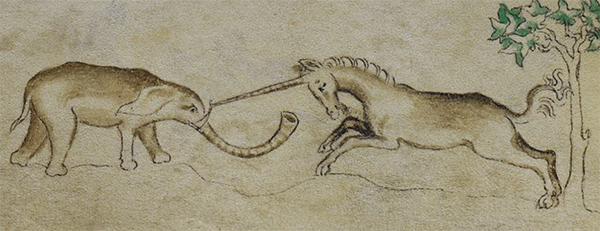
The elephant often fought with the unicorn, who could wound it in the belly with its horn. Its archenemy, however, was the dragon, which would lie in wait and then entangle the legs of the elephant in its coils and kill it by suffocation. The first Western account of what later would be known as a unicorn is by Ctesias, a Greek physician serving in the court of the Persian king Artaxerxes II, whose lost history of India was written about 400 BC. There he describes the wild Indian ass (onager), an extremely swift and strong animal, with a white body, blue eyes, and a crimson head—in the middle of which was a horn one-and-a-half cubits in length (a bit over two feet), white at the base, then black, and crimson at its sharp tip. When fashioned into cups, whoever drank from the horn was said to be immune from poison, as well as seizures and epilepsy. And it was for this alexipharmic horn, as well as the animal's astragalus or ankle bone (used as dice and "the most beautiful I have ever seen"), that the creature was hunted with javelin and bow, with many horses and men being killed in the process (Indica, frag. 45.45). The account, in fact, conflates two animals: the ass, fighting with its imagined horn and "kicking and biting," and the Indian rhinoceros. Admitting the gullible Ctesias to be "no very good authority, by the way" (History of Animals, VIII.28), Aristotle nevertheless repeats the notion that the Indian ass had a single horn, adding that the oryx did as well (II.1).
Pliny says the same thing (XI.cvi.255) but remarks that the rhinoceros, too, has a single horn projecting from its nose, as had been seen when one was exhibited at the games of Pompey the Great. (In fact, the first rhinoceros to be seen—and slain—in Rome was at the games of Octavian to celebrate his triumph over Cleopatra in 29 BC, Cassius Dio, Roman History, LI.22.5.) A natural enemy of the elephant, the rhinoceros had much shorter legs than its adversary, which allowed it to direct its horn, having been sharpened against rocks, at the elephant's belly, which it knew to be the softest and most vulnerable part (Pliny, VIII.xxix.71; Solinus, XXX.21).
Aelian elaborates on the strategy a century-and-a-half later. There was, at the end of the rhinoceros' nose, an exceedingly sharp horn whetted on rocks to be sharper still and hard as iron. Otherwise overmatched in height and strength, it slashed upwards from beneath—with many elephants dying in fights for pasturage. If the rhinoceros was not quick enough to draw blood, however, the elephant grabbed it firmly with its trunk and, pulling it from beneath its legs, attacked with its tusks (XVII.44).
Pliny describes yet another animal that had a single horn (but, in fact, referring again to the rhinoceros). Called by the Indians a monoceros (Latin unicornis, "one horn"), it was a fierce animal that made a deep lowing noise and could not be taken alive. Native to India, it was the size of a horse but with the head of a stag, the feet of an elephant, and the tail of a boar—and had a single black horn projecting two cubits from its forehead (VIII.xxxi.76).
Aelian identifies the same fabulous creature but says it was called a cartazonus, adding that its horn was not smooth but spiraled and its power invincible (XVI.20). Although only Aelian describes the horn as "having spirals of quite natural growth," this is how it often is illustrated in the medieval bestiaries. Sir Thomas Brown later comments on such a horn, comparing it to one preserved in Paris, with its "wreathy spires, and chocleary turnings"—a wonderfully archaic phrase that actually described the tusk of a narwhal (Pseudodoxia Epidemica, or Vulgar Errors, XXIII).
Writing in the seventh century AD, Isidore of Seville, conflates all these creatures: the rhinoceros (from the Greek and then Latin, meaning "horn on the nose") also was the monoceros—which is to say, the unicorn. It often fought with the elephant, wounding it with its four-foot horn (now almost twice as long as the one described by Ctesias over a thousand years earlier), which was so sharp and strong that it impaled and tossed in the air whatever the unicorn attacked. Indeed, such a ferocious beast could only be captured when lulled in the lap of a maiden (The Etymologies, XII.2.12-13). In the next paragraph, Isidore describes the elephant itself, remarking on its mountainous size, after which it was thought to be named (in fact, the etymology derives from the Greek for "ivory") and dutifully repeating what earlier authors already had said about it (XII.2.14-16).
The bas-de-page scene above (literally "bottom of the page") is from Royal 2.B.vii, a psalter dating to about 1310-1320. It illustrates a unicorn, as popularly imagined, confronting the elephant, although in the bestiaries the unicorn is portrayed as no bigger than a kid goat and resting in the lap of a maiden.
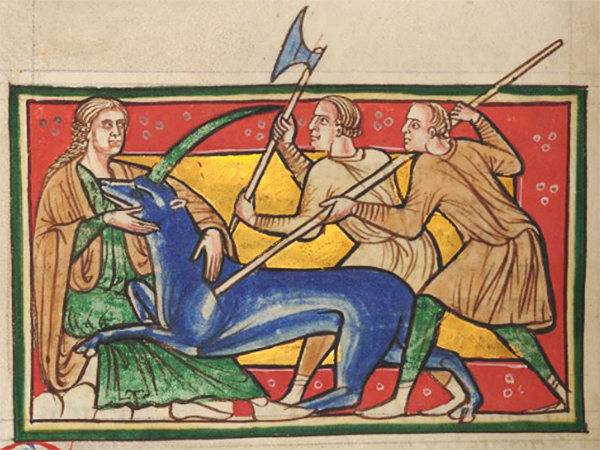
Given the savagery of the animal and its swiftness (certainly no hunter could catch it), the stratagem depicted in the bestiary was to leave a virgin maiden in the woods, where the unicorn would come and leap onto her lap and so be killed—as depicted in this illumination from Morgan MS 81 (circa 1185).
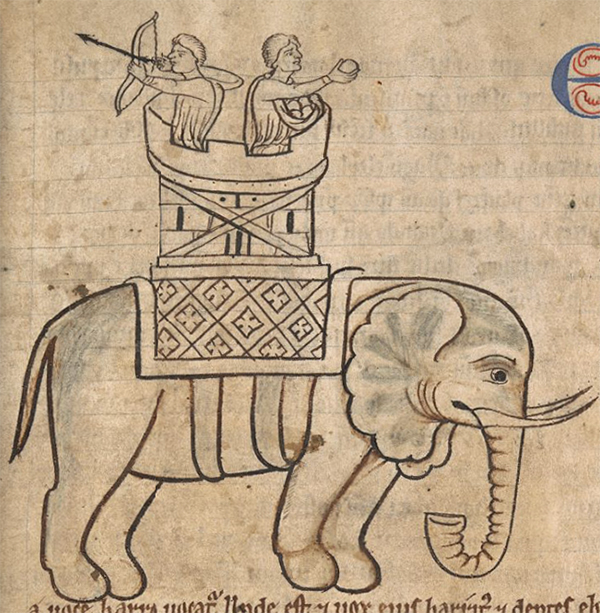
Dating to about 1170–1180, Additional MS 11283 (British Library) is the earliest example of a Second Family bestiary, the largest group and all of English origin—as contended by James, who was the first to categorize the Latin bestiaries in England into families. It follows the order of the beasts as presented in Isidore's Etymologies, beginning lion...tiger (De Animalibus, Bk. XII) and supplemented by additional material, principally from Solinus and Ambrose. The illustrations of Add. MS 11283 are mainly in brown ink, with some in a color wash. Isidore had remarked in the seventh century AD that the elephant was suited for warfare, "for the Persians and Indians, having set wooden towers on them, attack with javelins as if from a rampart" (XII.ii.15). This drawing is the earliest depiction in a bestiary of an elephant with a howdah or crenulated war-tower strapped on its back, the "elephant and castle" of medieval heraldry.
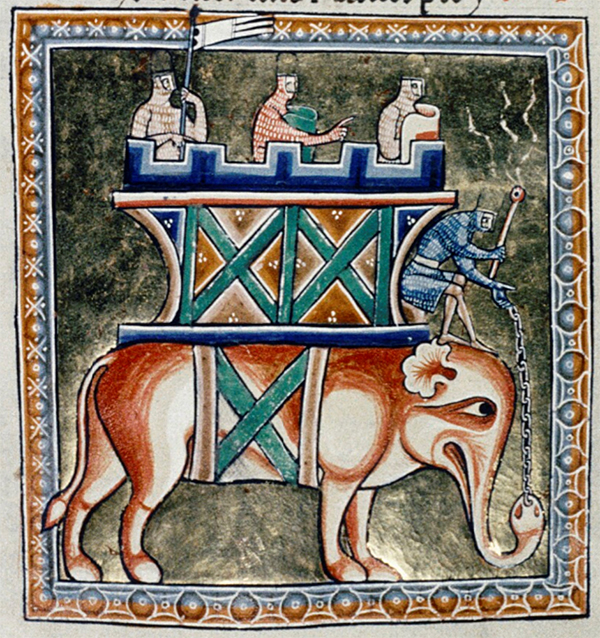
Closely related to the Aberdeen Bestiary (James calls them "sister manuscripts"), the Ashmole Bestiary (MS Ashmole 1511), circa 1200–1225, is perhaps the most luxurious and expensive bestiary, although it has been mutilated by the loss of several large illuminations cut from the page.
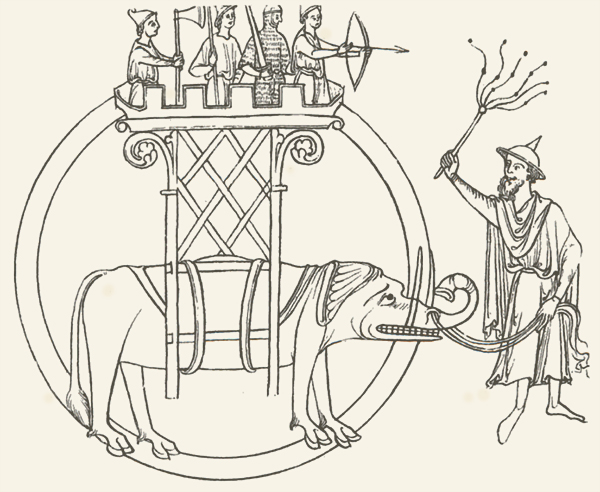
The Cambridge Bestiary (MS Ii.4.26) is in the University Library there and dates to about 1200 (or even as late as the 1220s) and possibly is from Lincolnshire. Although the lion is illuminated in color, the majority of the illustrations are simple ink-and-wash drawings—which may be why, in 1928, James chose to reproduce this particular bestiary for a private printing by the Roxburghe Club, a society devoted to the publication of rare texts. There, he offered "a Preliminary Study of the Latin Bestiary as Current in England," in which he first proposed that they be classified as belonging to one of four families, each with shared characteristics—a categorization later revised by McCulloch who, rather than combining the features of First and Second Families, added a Transitional Family. In 1954, James' facsimile was used by T. H. White (the author of the The Once and Future King) to provide the first and for some time, the only, translation of a bestiary in English. Barber's translation of Bodley 764, for example, did not appear until 1992.
As shown in the drawing, the text tells of Persians and Indians placing wooden towers on the backs of elephants from which they fought each others with javelins, as if from a castle. But what is unusual about this particular illustration is the large figure of the manhout who drives the animal. Bearded, his head is covered with a pileum cornutum ("horned cap"), the cone-shaped hat worn by Jews in medieval Europe that publicly differentiated them from the rest of the population. Promulgated by Pope Innocent III at the Fourth Lateran Council in 1215, the edict was adopted in England three years later (although more ambiguous references to distinctive Jewish clothing occur as early as 1200).
Moreover, he brandishes, not a conventional whip, but a knotted scourge, which the fearful elephant looks at with palpable trepidation. As Jews in the Bible had scourged and humiliated Jesus, so in the allegory the elephant is scourged by its Jewish handler. So, too, the knights in their crenellated castle are reminiscent of the crusaders, the Third Crusade having abandoned its attempt to recapture Jerusalem only in 1192 and the revered Richard I (the Lionheart) dying in 1199 before he could return home. A Fourth Crusade had been summoned in 1198—which instead found it more profitable to sack the Byzantine capitol of Constantinople in 1204.
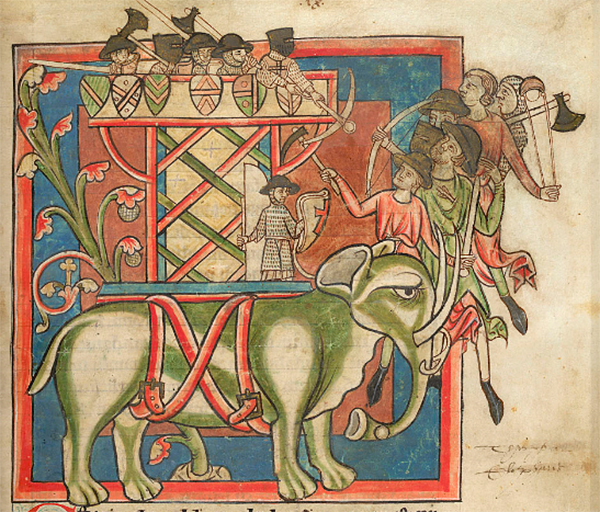
Harley 4751 is associated with Salisbury and dates to about 1225–1250. Although no gold leaf is used, it is considered a luxury manuscript by virtue of its large illustrations (many of which derive from the Cambridge Bestiary) and broad color panels. Too, with the inclusion of birds from the Topographia Hibernica ("Topography of Ireland," c. 1188) by Gerald of Wales, it is one of the most comprehensive of the Second Family bestiaries. These additions include the barnacle goose (I.11), osprey (I.12), and dipper (I.13), which Gerald called "martinets" and were thought to be a local variety of kingfisher. There also is the badger (I.20) which, in digging a burrow, allows the dirt to be piled up on its belly like a sledge. Then, by means of a stick held in its teeth, the creature and its mound of excavated soil are pulled backward out of the newly-dug hole by its compatriots.
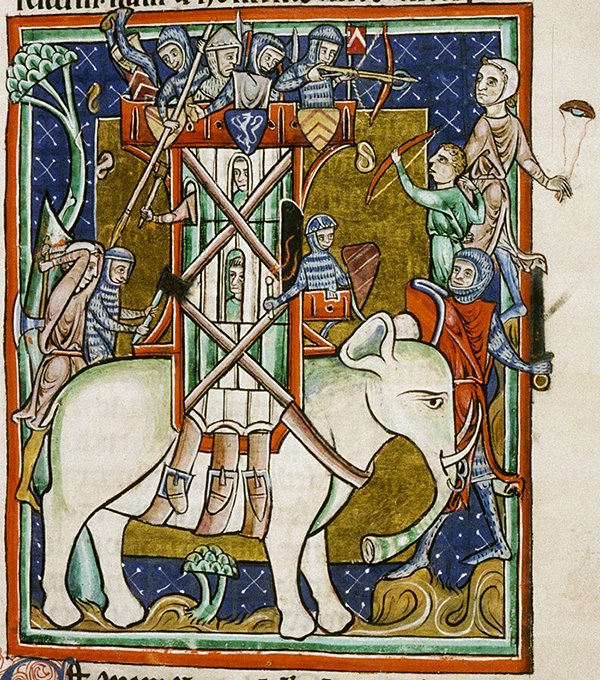
Bodley 764 (Bodleian Library) is another example of a luxury manuscript and shares the same locale and date as Harley 4751, with which it is closely related. Hunting scenes are rendered with special drama and even violence. This bestiary may be the only one that can be ascribed to secular patronage, as the heraldic shield (blazoned "Azure, a lion rampant argent") so prominently displayed in the center of the elephant-and-castle illumination belonged to a baron Roger de Monhaut, who likely commissioned it. Women, too, are depicted in scenes that lack them elsewhere and, when animal species are presented, the female is shown more often than in other manuscripts. Bodley 764 would seem, therefore, to have been intended to appeal to well-born ladies in particular.
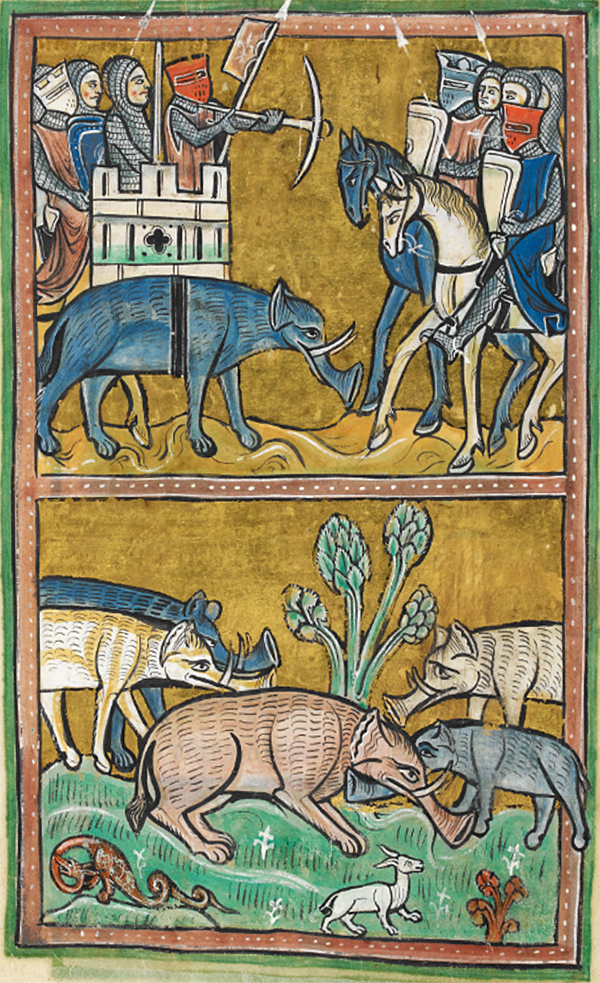
The Rochester Bestiary (Royal MS 12 F XIII), named after the Benedictine Cathedral Priory there, dates to about 1230 and includes additions from the Pantheologus of Peter of Cornwall. It is characterized by McCulloch as a Second Family bestiary but "unrelated iconographically" in that it does not resemble the pictorial motifs of other manuscripts in the family. Here, for example, the much smaller elephant, looking more like a tusked boar, confronts knights on decidedly wary horses.
The elephant was thought to have no joints in its knees. Unable to rise if it ever fell, it was thought to sleep on its feet, supported by a tree—this, in spite of Aristotle insisting that "The elephant does not sleep standing, as some were wont to assert, but it bends its legs and settles down" (II.1). the second panel shows it struggling to right itself. Hunters in India were said to saw partly through the tree, so that the elephant, leaning against it, would topple to the ground. Trumpeting its alarm, neither a large elephant nor twelve more were able to raise it. Only a single small elephant, using its trunk, could lift the fallen animal. Thought to have no joints in its knees, the elephant has leaned against a tree to sleep, only to fall down. As White translates the corresponding passage in the Cambridge Bestiary, the elephant calls out, unable to right itself. But even a larger elephant cannot help him. Concerned, more elephants then arrive but they, too, are unable to lift the fallen creature. All of them then cry out until a much smaller elephant comes and, extending its trunk, lifts him up.
In the allegory, the larger elephant is Hebrew Law, which fails to lift up Man; nor can the other elephants, the Prophets. Only Jesus, the least significant of them, can raise up and redeem mankind, teaching, like the small elephant, the power of the humble and meek. The story also relates to the Samaritan, where Christ lifts up the wayfarer, who has fallen among thieves and been abandoned by the Pharisee and the Levite, and offers him succor (Luke 10:30–37). Curiously, the dragon in the corner of the panel, otherwise so fatal to the elephant, seems particularly unthreatening.
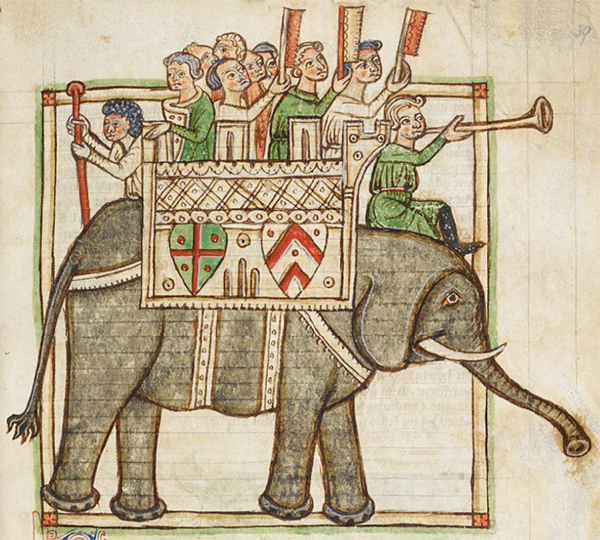
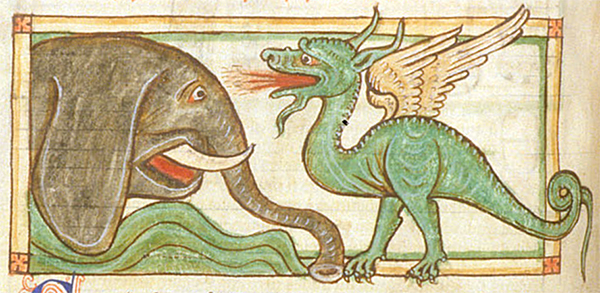
Harley MS 3244 (British Museum) is a Second Family Bestiary and includes some of the most realistic drawings of an elephant. The manuscript dates to some time after 1236—and possibly to about 1255, which was the year the first elephant was seen in England, a present from Louis IX of France to Henry III. (Or it may have been based on a picture by Matthew Paris that illustrated his Chronica Majora.)
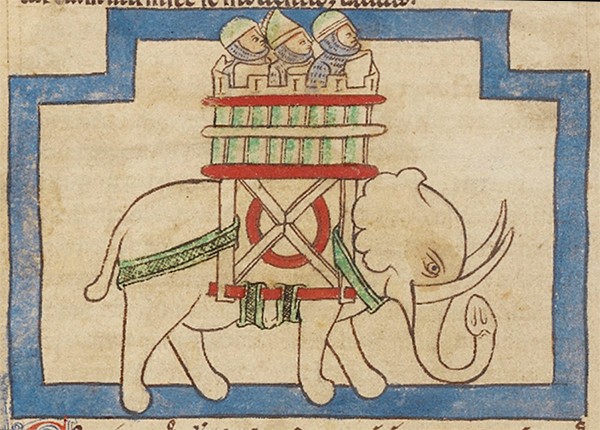
The Northumberland Bestiary (MS 100), as it now is called, dates to about 1250–1260. It is almost identical to Royal 12 C.xix and even may have been copied from it, but, unlike the richer colors and gold grounds of more luxurious Transitional bestiaries, the drawings are outlined in brown ink and delicately tinted by layers of colored wash, the pigmented tones allowing for subtle gradations of color. Some of the images, too, are drawn more naturalistically, even if the colors are purely decorative and conventional. Originally owned by the Duke of Northumberland through marriage, it then was called the Alnwick Bestiary (after the ancestral seat at Alnwick Castle). In 1990, it was sold at auction to a private collector in the United States for £2,970,000 ($5,834,565, the rate of exchange on the date of sale)—the highest price ever paid for an English manuscript. One of the last bestiaries still in private hands, it was purchased (after a failed earlier attempt in 1990) by the J. Paul Getty Museum (Los Angeles) in 2007 for a reputed £20,000,000—and freely made available online as part of the Museum's Open Content Program.
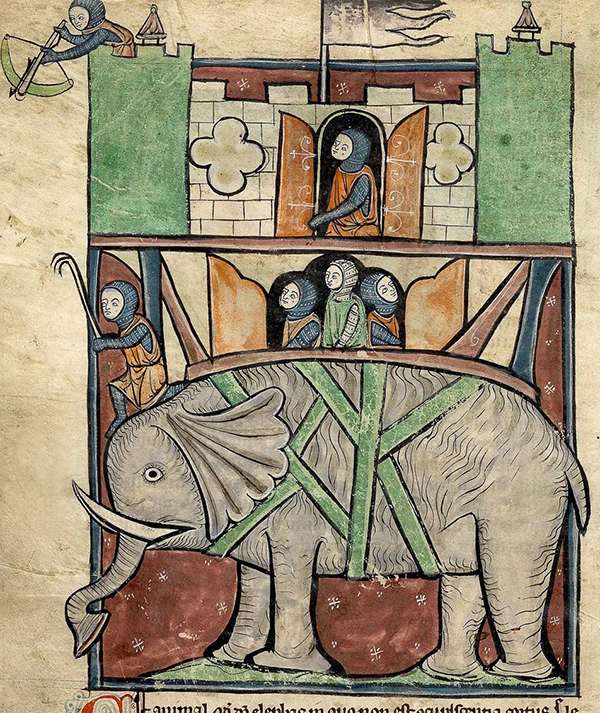
An example of a Third Family bestiary, the Westminster Bestiary (MS 22) dates to about 1270–1290 and resides in the Library of Westminster Abbey (London). The ordering of beasts has changed and begins with domestic animals, followed by wild beasts, birds, fish, snakes, and insects.
Aristotle seems so knowledgeable about the elephant, its anatomy and behavior, that it has been speculated that he must have had ongoing contact with his former pupil, Alexander the Great. It was said that Aristotle had received eight hundred talents from Alexander to continue his study of animals (Athenaeus, Deipnosophists, IX.398e). Indeed, says Pliny, so determined was Alexander to learn about their nature that he
"entrusted the prosecution of this design to Aristotle, a man who held the highest rank in every branch of learning; for which purpose he placed under his command some thousands of men in every region of Asia and Greece, and comprising all those who followed the business of hunting, fowling, or fishing, or who had the care of parks, herds of cattle, the breeding of bees, fish-ponds, and aviaries, in order that no creature that was known to exist might escape his notice. By means of the information which he obtained from these persons, he [Aristotle] was enabled to compose some fifty volumes, which are deservedly esteemed, on the subject of animals" (VIII.xvii.44).
Such largess, however, may have been exaggerated by the opponents of Aristotle to discredit him. And, indeed, following the death of Alexander, Aristotle was compelled to leave Athens, when anti-Macedonian sentiment turned against them both (cf. Diogenes Laertius, Lives of Eminent Philosophers, V.5–6).
The mosaic (top), which is in the Carthage Museum, is a detail from a large piece depicting animals being hunted and captured for the amphitheater. Here, an elephant, its wrinkled skin represented by cross-hatching, is being cruelly bitten by a boa that has entwined itself around the hapless beast.
References: Mosaics of Roman Africa: Floor Mosaics from Tunisia (1996) by Michèle Blanchard-Lemée, Mongi Ennaïfer, Hédi Slim, and Latifa Slim; "The Elephant in Medieval Legend and Art" (1919) by G. C. Druce, Archaeological Journal, 76, 1-73. The Elephant in the Greek and Roman World (1974) by H. H. Scullard; Animals in Art and Thought to the End of the Middle Ages (1971) by Francis Klingender; The Etymologies of Isidore of Seville (2006) by Stephen A. Barney, W. J. Lewis, J. A. Beach, and Oliver Berghof. The Lore of the Unicorn (1930) by Odell Shepard; "A Baronial Bestiary: Heraldic Evidence for the Patronage of MS Bodley 764" (1987) by Ronald Baxter, Journal of the Warburg and Courtauld Institutes, 50, 196-200.
See also The Elephant in Rome.